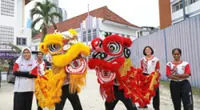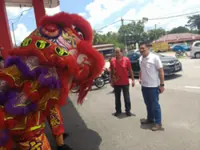For residents of Kampung Batu Lima, the rhythmic beats of drums and sight of two green lions dancing through their streets during Hari Raya Aidilfitri made a lasting and memorable impression. — Courtesy photos
Multiracial troupe takes Chinese traditional act to homes of students, villagers
FOR residents of Kampung Batu Lima, a quiet Malay village in Muar, Johor, the rhythmic beats of drums and sight of two “lions” dancing through the streets during Hari Raya Aidilfirti proved to be unforgettable.
Decked out in custom-made green costumes bearing the festive greeting “Selamat Hari Raya Aidilfitri” on the back of their heads, the team from the Bakri Kun Seng Keng Lion and Dragon Dance Association brought a burst of energy to the kampung.
ALSO READ: Youths learn discipline, resilience in artform
Association founder and coach Chong Kok Fu said the villagers were surprised at their presence as lion dances were rarely, if ever, seen in the kampung.
“It has always been my dream to share our lion dance with more Malaysians beyond the Chinese community.
“This Hari Raya gave us the perfect opportunity to celebrate with the villagers at their homes,” he told StarMetro.
The group spent two days visiting various houses, including that of Chong’s secondary school teacher Norlizah Md Ali, who is now retired.
The lions troupe spread festive cheer through their performances and also handed out fresh oranges to the villagers.
Chong said the visits were especially meaningful as they included stops at the homes of the association’s Malay students.
“We sought permission before the visits and were touched by their hospitality,” he said.
“Many came out of their houses to watch the performance, while some called relatives and friends over to witness the show.
“The moment we arrived with our drums and cymbals, people rushed out to take photos and videos. It was also heartwarming when some of the villagers gave our performers duit raya.”
Chong said the troupe kept their performances purely cultural and celebratory.
The green costumes, costing about RM4,000, were ordered a month in advance and were intentionally designed that way instead of the traditional red, he said.
The association, with over 90 members aged 10 and above, includes five Malay and five Indian students who are learning the art of lion and dragon dances.
Chong hoped such events would help break stereotypes and show that lion and dragon dances were not necessarily exclusive to any race or religion.
He said the troupe was promoting the traditional dances as a sport and cultural art that belonged to all Malaysians.
“We have seen Indian drums or kompang being incorporated into lion dances.
“Our hope is for lion and dragon dances to be celebrated across communities and one day, be seen as a Malaysian tradition,” he said, adding that the positive response had inspired plans for another cross-cultural celebration during Deepavali this year.
For Malaysia Yahya Awal Dragon Dance Troupe coach Amos Poh, the beauty of dragon dance lies not just in its acrobatic flair but also in its ability to bring Malaysia’s multicultural people together through shared passion and discipline.
He said dragon dance, rooted in Chinese culture, has evolved into a sport that was being embraced by schools and communities nationwide.
“Our troupe has welcomed non-Chinese members with open arms over the years.
“Dragon dance today is not just a cultural tradition – it is a team sport that builds coordination, teamwork and discipline.
“Many public schools have their own lion and dragon dance teams and it is heartening to see multiracial students performing together,” he said.
Currently, the troupe has three non-Chinese students, with the youngest being 10 years old.
Over the course of its 51-year history, Poh said the dance company has trained and produced a handful of Malay and Indian dragon dancers, and was open to taking in more.
Some practical challenges still exist especially when it came to language, he said.
“The dragon dance movements and patterns have Chinese names, so our non-Chinese students have to memorise the terms in Mandarin.
“It takes some getting used to, but they have managed well with practice and guidance,” he added.
Poh said the troupe also made it a point to accommodate students’ cultural and religious needs to make training accessible for everyone.
This included ensuring Muslim students are provided halal food during practice and events, with parents informed from the outset about their sensitivities being taken into account.
While training takes place within the compound of the Yahya Awal Ang Sian Tai Tee Temple in Taman Molek, Johor Baru, Poh said the students were not required to enter the temple itself and the routines were not religious in nature.
“So far, the parents have been understanding and supportive as they see how much their children enjoy learning and performing.
“They also have the chance of competing in national and international events,” Poh said, adding that the troupe held the Malaysia Book of Records title for winning the most number of dragon dance championships – 74 titles and counting.
The coach said a highlight for the troupe this year was a cultural performance at a concert in EduCity in Iskandar Puteri, Johor where dragon dance were fused together with silat and kompang – two traditional Malay artforms.
“It was a beautiful blend of cultures. We want to show that traditional arts can coexist harmoniously and that there is space for everyone to take part,” he said.
The troupe currently has seven dragon dance teams of 10 people, each training three nights a week from 9pm to midnight.
Its members include school students and working adults.
“Some of our students travel from places like Pekan Nanas and Kulai for training,” he said.
“To ease their burden, we subsidise transport costs like e-hailing fares to encourage continued participation.
“It is a small price to pay to keep their passion alive. As long as they stay committed, we will support them however we can.”









